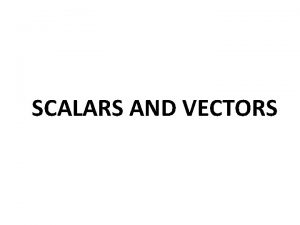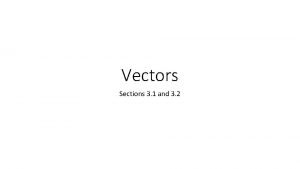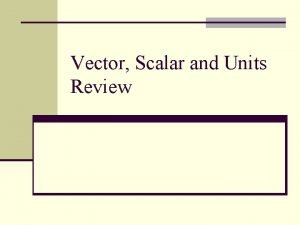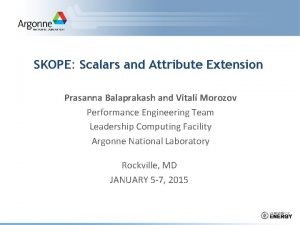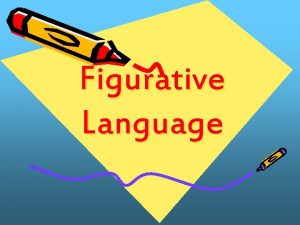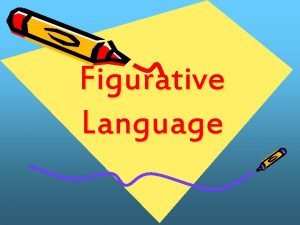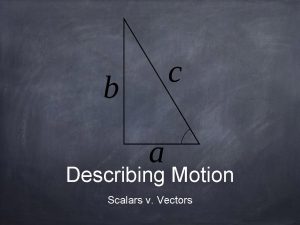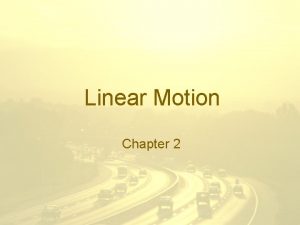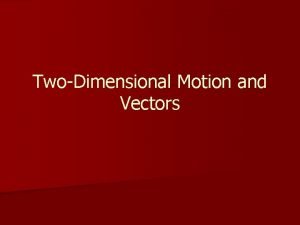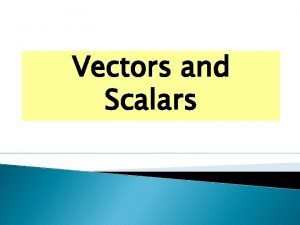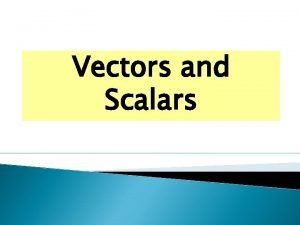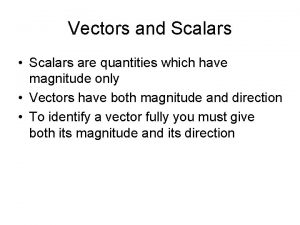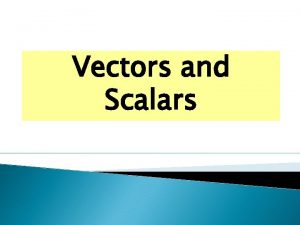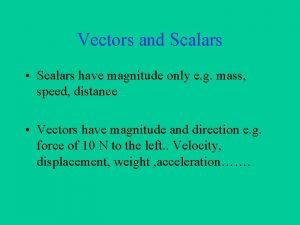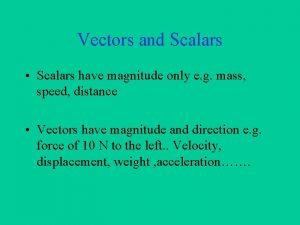The Language of Motion Vectors versus Scalars Scalars


















- Slides: 18

The Language of Motion

Vectors versus Scalars • Scalars: Include magnitude but not direction – Eg. 100 km/h (which way? ) • Vectors:

Vectors versus Scalars • Scalars: Include magnitude but not direction – Eg. 100 km/h (which way? ) • Vectors: Includes magnitude and direction – Eg 100 km/h West , 100 km/h [W]

Distance versus Position Distance (d): How far you travelled. Does not include direction (scalar) – eg. 45 km or 60 m Position (d):

Distance versus Position Distance (d): How far you travelled. Does not include direction (scalar) – eg. 45 km or 60 m Position (d): Describes the where you are relative to a reference point. Includes direction (vector) – Eg. 45 km East or 60 m (W)

Example of Distance and Position Distance (How far did the ship travel): Position (How far is the ship from the dock):

Example of Distance and Position Distance (How far did the ship travel): 12 km Position (How far is the ship from the dock): 8 km

Time(t): Describes when something occurs Two times in physics Initial Time: Final Time : Time interval:

Time(t): Describes when something occurs Two times in physics Initial Time: When the event begins – Eg class starts at 9: 00 Final Time : When the event ends – Eg class ends at 10: 30 Time interval:

Time(t): Describes when something occurs Three times in physics Initial Time: When the event begins – Eg class starts at 9: 00 Final Time : When the event ends – Eg class ends at 10: 30 Time interval: How much time the event took up. The difference between the initial and final time 10: 30 – 9: 00 = 1: 30 the time interval was 1 hour and 30 min

The symbol for change Δ Time interval= change in time = Δt

SI units (Standard units) Time = s Distance = m

Calculating time intervals 1) Find the initial time and the final time. 2) Subtract the initial time from the final time Eg

Calculating time intervals 1) Find the initial time and the final time. 2) Subtract the initial time from the final time Tf - Ti = ΔT Eg 5 s – 2 s = 3 s Time interval = 3 s

Displacement and Distance Displacement (Δd): the straight line distance and direction between two points. Eg Δd = df - di =

Displacement and Distance Displacement (Δd): the straight line distance and direction between two points. Eg Δd = df - di = 3 m(E) – 2 m (W) East is considered + West is considered – 3 m - (-2 m) = 5 m

Positive directions versus Negative directions • Positive: up and north • Negative: down and south east and right west and left

Uniform Motion: Motion that does not change. Do not speed up or slow down. Graphing uniform motion: Next class
 A storm system moves 5000 km due east
A storm system moves 5000 km due east Magnitude of a vector
Magnitude of a vector Scalar and vector quantity
Scalar and vector quantity Scalars and vectors
Scalars and vectors Multiplying or dividing vectors by scalars results in:
Multiplying or dividing vectors by scalars results in: Lesson plan on vectors and scalars
Lesson plan on vectors and scalars Power is scalar or vector
Power is scalar or vector Two dimensional motion and vectors
Two dimensional motion and vectors Prasanna balaprakash
Prasanna balaprakash Allusion figure of speech meaning and examples
Allusion figure of speech meaning and examples Shampoo simile hyperbole
Shampoo simile hyperbole Range of motion definition
Range of motion definition Simple harmonic motion formula sheet
Simple harmonic motion formula sheet An object in motion stays in motion
An object in motion stays in motion Chapter 2 motion section 1 describing motion answer key
Chapter 2 motion section 1 describing motion answer key Chapter 2 motion section 1 describing motion answer key
Chapter 2 motion section 1 describing motion answer key Chapter 2 section 1 describing motion answer key
Chapter 2 section 1 describing motion answer key Section 1 describing motion
Section 1 describing motion Section 1 describing motion
Section 1 describing motion



